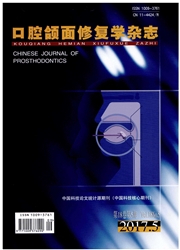

 中文摘要:
中文摘要:
目的:应用PET方法研究下颌第三磨牙拔除4h后疼痛状态下的脑激活区分布,并推测不同分区的参与状况及其作用。方法:筛选口颌系统功能及形态正常的志愿者6例,设拔牙前一天利多卡因阻滞麻醉4h后的PET检查为对照组。设拔牙4h后感到明显疼痛时(VAS≥5)的PET检查为实验组。SPM2分析。结果:左侧大脑豆状核、BA7、BA8、BA9、BA10、BA18、BA19、BA43、BA47区域,有明显的代谢升高。结论:豆状核、额上回、额中回、额下回、中央后回、楔前叶、枕叶楔叶、枕中回等是被拔牙活动所激活的脑区。
 英文摘要:
英文摘要:
Objective: To study cerebral responses in patients suffering from post-mandibular third molar-extraction pain by positron emission tomography (PET). Methods: 6 cases were to pull out mandibular third molar. The PET inspections before teeth extraction were set as control group. The PET inspections 4h after teeth were extracted and patients felt evident pain were set as experiment group. 18F-FDG was chosen as tracer. SPM2 was applied for analysis. Results: There was an evident metabolic rise of glucose in Lenticular Nucleus, Brodman's area 7, 8, 9, 10, 18, 19, 43, 47. Conclusion: These brain areas, i.e. Lenticular Nucleus, superior frontal Gyms, middle frontal Gyms, inferior frontal Gyms, Postcentral Gyms, Precuneus, Cuneate Lobe, Middle Occipital Gyrus, are the Cerebral responding areas related to post-mandibular third molar- extraction pain.
 同期刊论文项目
同期刊论文项目
 同项目期刊论文
同项目期刊论文
 期刊信息
期刊信息
